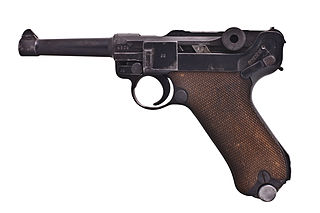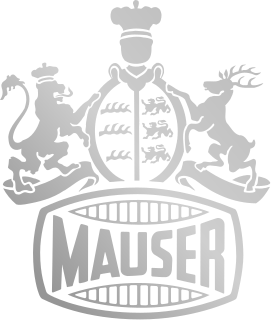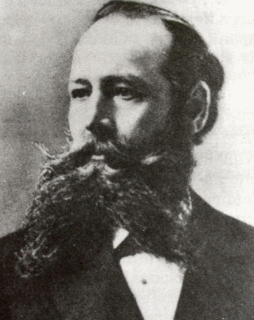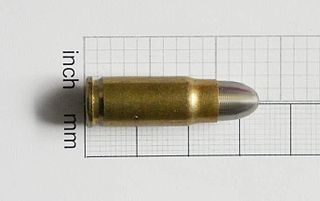
The Pistole Parabellum—or Parabellum-Pistole, commonly known as just Luger or Luger P08 is a toggle-locked recoil-operated semi-automatic pistol. The Luger was produced in several models and by several nations from 1898 to 1949.

The Karabiner 98 kurz, often abbreviated Karabiner 98k, Kar98k or K98k and also sometimes incorrectly referred to as a K98, is a bolt-action rifle chambered for the 7.92×57mm Mauser cartridge. It was adopted on 21 June 1935 as the standard service rifle by the German Wehrmacht. It was one of the final developments in the long line of Mauser military rifles.

Mauser, originally Königlich Württembergische Gewehrfabrik , is a German arms manufacturer. Their line of bolt-action rifles and semi-automatic pistols has been produced since the 1870s for the German armed forces. In the late 19th and early 20th centuries, Mauser designs were also exported and licensed to many countries which adopted them as military and civilian sporting firearms. The Mauser Model 98 in particular was widely adopted and copied, and is the foundation of many of today's sporting bolt-action rifles.

The Gewehr 41, commonly known as the G41(W) or G41(M), denoting the manufacturer, is a battle rifle manufactured and used by Nazi Germany during World War II. It was largely superseded by the Gewehr 43, which incorporated a more reliable method of operation.

The Mauser C96 is a semi-automatic pistol that was originally produced by German arms manufacturer Mauser from 1896 to 1937. Unlicensed copies of the gun were also manufactured in Spain and China in the first half of the 20th century.

A semi-automatic pistol is a type of repeating single-chamber handgun (pistol) that automatically cycles its action to insert the subsequent cartridge into the chamber (self-loading), but requires manual actuation of the trigger to actually discharge the following shot. As a result, only one round of ammunition is fired each time the trigger is pulled, as the pistol's fire control group disconnects the trigger mechanism from the firing pin/striker until the trigger has been released and reset.

Peter Paul Mauser, after 1912 von Mauser, was a German weapon designer, manufacturer/industrialist and politician.

A gunsmith is a person who repairs, modifies, designs, or builds guns. The occupation differs from an armorer, who usually replaces only worn parts in standard firearms. Gunsmiths do modifications and changes to a firearm that may require a very high level of craftsmanship, requiring the skills of a top-level machinist, a very skilled woodworker, and even an engineer. Gunsmiths perform factory-level repairs and renovations to restore a well-used or deteriorated firearms to new condition. They may make alterations to adapt sporting guns to better fit the individual shooter that may require extensive modifications to the firearm's stocks and metal parts. Repairs and redesigns may require fabrication and fitting of unavailable parts and assemblies constructed by smiths themselves. Gunsmiths may also renew metal finishes or apply decorative carvings or engravings to guns. Many gun shops offer gunsmithing service on the premises.

Deutsche Waffen- und Munitionsfabriken Aktiengesellschaft, known as DWM, was an arms company in Imperial Germany created in 1896 when Ludwig Loewe & Company united its weapons and ammunition production facilities within one company. In 1896 Loewe founded Deutsche Waffen- und Munitionsfabriken with a munitions plant in Karlsruhe (Baden), formerly Deutsche Metallpatronenfabrik Lorenz, and the weapons plant in Berlin. Shares that Loewe had in other gun- and ammunition plants were transferred to DWM. This included Waffenfabrik Mauser, Fabrique Nationale d'Armes de Guerre (FN) in Belgium and Waffen- und Munitionsfabrik A.G. in Budapest. The DWM was orchestrated by Isidor Loewe (1848–1910), as his brother Ludwig had died in 1886. Karl Maybach was employed by the Loewe company in 1901.

The Gewehr 98 is a German bolt-action rifle made by Mauser, firing cartridges from a five-round internal clip-loaded magazine. It was the German service rifle from 1898 to 1935, when it was replaced by the Karabiner 98k, a shorter weapon using the same basic design. The Gewehr 98 action, using a stripper clip loaded with the 7.92×57mm Mauser cartridge, successfully combined and improved several bolt-action engineering concepts which were soon adopted by many other countries, including the United Kingdom, United States, and Japan. The Gewehr 98 replaced the earlier Gewehr 1888 as the main German service rifle. It first saw combat in the Chinese Boxer Rebellion and was the main German infantry service rifle of World War I. The Gewehr 98 saw further military use by the Ottoman Empire and Nationalist Spain.

The 7.92×57mm Mauser is a rimless bottlenecked rifle cartridge. The 7.92×57mm Mauser cartridge was adopted by the German Empire in 1903–1905, and was the German service cartridge in both World Wars. In its day, the 7.92×57mm Mauser cartridge was one of the world's most popular military cartridges. In the 21st century it is still a popular sport and hunting cartridge that is factory-produced in Europe and the United States.

The Gewehr 88 was a late 19th-century German bolt-action rifle, adopted in 1888.

Oberndorf am Neckar is a town in the district of Rottweil, in Baden-Württemberg, Germany. It is situated on the river Neckar, 15 kilometres north of Rottweil. It historically was and currently is a major center of the German weapons industry.

Zastava Arms is a Serbian manufacturer of firearms and artillery, based in Kragujevac, Serbia. It was founded in 1853 when it cast its first cannon. It is the leading producer of firearms in Serbia and is a large contributor to the local defense industry. Zastava Arms produces and exports a wide variety of products to over forty countries, including the popular Zastava M70, a Kalashnikov rifle.

Wilhelm Mauser was a German weapon designer and manufacturer/industrialist.

The StG 45(M) sometimes referred to as the MP 45(M), was a prototype assault rifle developed by Mauser for the Wehrmacht at the end of World War II, using an innovative roller-delayed blowback operating system. It fired the 7.92×33mm Kurz intermediate cartridge at a cyclic rate of around 450 rounds per minute.
The evolution of German military rifles is a history of common and diverse paths followed by the separate German states, until the mid-19th century when Prussia emerged as the dominant state within Germany and the nation was unified. This article discusses rifled shoulder arms developed in or for the military of the states that later became Germany; it excludes firearms of the Austrian Empire, except where they were used substantially by German troops.

Theodor Bergmann was a German businessman and industrialist best remembered for the various revolutionary firearms his companies released. Like many entrepreneurs of the era, his activities centered on bicycles, and the nascent automobile. Armament was not Bergmann's primary focus, but the one he was most attracted to, which was the reason most of his pistols were manufactured under license once they were created. He is famous for creating automatic pistols, and their ammunition.

The 7.63×25mm Mauser round was the original cartridge for the Mauser C96 service pistol. This cartridge headspaces on the shoulder of the case. It later served as the basis for the 7.62mm Tokarev cartridge commonly used in Soviet and Eastern Bloc weapons.
Events in the year 1882 in Germany.

















